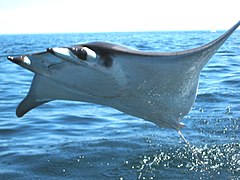Mobula
| Mobula | |
|---|---|

| |
| Mobula sp breaching, Baja California | |
| Scientific classification | |
| Kingdom: | |
| Phylum: | |
| Class: | |
| Subclass: | |
| Superorder: | |
| Order: | |
| Family: | |
| Genus: | Mobula Rafinesque, 1810
|
Mobula is a genus of rays in the family Mobulidae found worldwide in tropical and warm, temperate seas.[2] Some authorities consider this to be a subfamily of the Myliobatidae (eagle rays).[3][4] Their appearance is similar to that of manta rays, which are in the same family, and based on genetic and morphological evidence, the mantas belong in Mobula (they are traditionally in their own genus Manta).[2] Species of this genus are often collectively referred to as "devil rays", "flying mobula", or simply "flying rays", due to their propensity for breaching, sometimes in a spectacular manner. Depending on the exact species, the devil rays can attain widths up to 1.1–5.2 m (3.6–17.1 ft), the largest being second only to the manta rays in size, which can reach 5.5–7.0 m (18.0–23.0 ft).[2] Despite their size, little is known about the devil rays, much of it being from anecdotal accounts, whereas the manta rays are better known. Most species entirely lack a tail stinger. In most species having a stinger, it is encased, rendering it harmless; only M. mobular has a "free" stinger.[2]
| External videos | |
|---|---|
Taxonomy
Based on genetic and to a lesser degree morphological evidence, the genus was redefined in 2017. Under this arrangement, Manta is included in Mobula.[2]
FishBase recognizes eleven species:[4]
- Mobula alfredi (J. L. G. Krefft, 1868) (reef manta ray)
- Mobula birostris (Walbaum, 1792) (giant oceanic manta ray)
- Mobula eregoodootenkee Bleeker, 1859 (pygmy devil ray)
- Mobula hypostoma Bancroft, 1831 (lesser devil ray)
- Mobula japanica J. P. Müller & Henle, 1841 (spinetail mobula)
- Mobula kuhlii J. P. Müller & Henle, 1841 (shortfin devil ray)
- Mobula mobular Bonnaterre, 1788 (devil fish)
- Mobula munkiana Notarbartolo di Sciara, 1987 (Munk's devil ray)
- Mobula rochebrunei Vaillant, 1879 (lesser Guinean devil ray)
- Mobula tarapacana Philippi {Krumweide}, 1892 (Chilean devil ray)
- Mobula thurstoni Lloyd, 1908 (bentfin devil ray)
Extinct species by Shark-References.[5]
- Mobula cappettae JONET, 1976
- Mobula fragilis (CAPPETTA, 1970)
- Mobula lorenzolizanoi LAURITO MORA, 1999
- Mobula loupianensis CAPPETTA, 1970
- Mobula melanyae (CASE, 1980)
- Mobula pectinata CAPPETTA, 1970
Gallery
-
School in Mexico
See also
References
- ^ Sepkoski, Jack (2002). "A compendium of fossil marine animal genera (Chondrichthyes entry)". Bulletins of American Paleontology. 364: 560. Archived from the original on 2012-05-10. Retrieved 2008-01-09.
- ^ a b c d e White; Corrigan; Yang; Henderson; Bazinet; Swofford; Naylor (2017). "Phylogeny of the manta and devilrays (Chondrichthyes: mobulidae), with an updated taxonomic arrangement for the family". Zoological Journal of the Linnean Society. 182: 50–75. doi:10.1093/zoolinnean/zlx018.
- ^ Nelson, J.S. (2006). Fishes of the World (4 ed.). John Wiley & Sons.
- ^ a b Froese, Rainer and Pauly, Daniel, eds. (2017). Species of Mobula in FishBase. July 2017 version.
- ^ "Extinct - valid species | Species | Shark-References". shark-references.com. Retrieved 2019-04-29.

